高中英语必修四unit4Reading
高中英语必修四4_Unit4_Body_language_Reading新人教版
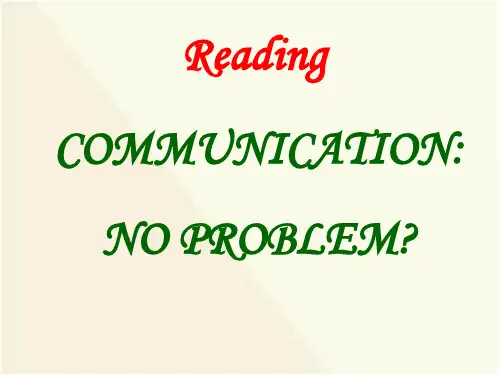
A conclusion of the passage.
Careful reading
( Read para1-2 Find out the answers to the questions)
1 Who will be present at the meeting?
people from different countries
a Japanese The second mistake
George Cook from (Canada)
He ________ bowed to Mr. Cook and his nose touched Mr. _________ moving Cook’s _______ ________. hand He ________ reached his hand ________ _______ ________ to the out Japanese.
Para.1-2 (example)
people present local businessmen
people representing the Chinese government
2 Why are people visiting China?
purpose mistakes
interest
People from different countries misunderstand each other.
He approaches Ms Smith Mr. Garcia by touching _______ ______ her from The _________ _______ shoulder and kissing (Columbia ) first her on the ________. cheek mistake She ______ stepped ________ back Julia Smith appearing surprised _________ from and take a few steps (Britain) away from _______ ______ Mr. Garcia.
2020新译林版高中英语选择性必修四Unit4 Reading重点知识点讲解课件

从基础层面上讲 旨在,目的是 能够做… 适应…,调整… 执行任务 提出 使某人能够做… 有能力做… 大量
one of+可数名词复数 …之一
1.One of the essential aims of AI is to develop computer intelligence
capable of learning from experience, adjusting to new inputs and
in short (L31) it is clear that… (L31) be at a turning point (L32) learn from mistakes (L33) get close to (L34) work to our advantage (L37) commit crimes (L42) become dependent on (L43) urge sb. to do (L43)
不定式作目的状语
介词短语作后置定语
2.To achieve this aim, many approaches to creating true AI have been put
forward, including “deep learning”,[which enables a machine to improve its
译文:从自动驾驶车辆到家用机器人,从推荐系统到撰写小说的电脑,AI有着 不计其数的应用。
翻译:从弱小到强大,从穷人到富人,这对人来说是个艰难的转变过程。
From the weak to the powerful, from the poor to the rich, it is a difficult transition for people.
人教版高中英语必修四 Unit4 Body Language reading 课件
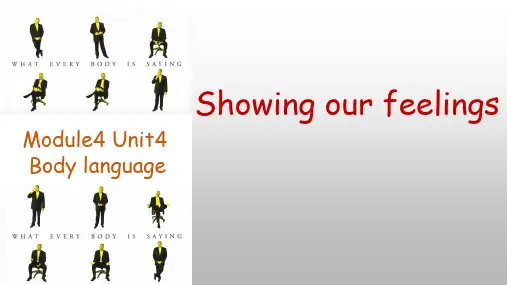
Para1 Body language is one of the most powerful means of communication, often even more powerful than spoken language. People around the world show all kinds of feelings, wishes and attitudes that they might never speak aloud. It is possible to "read" others around us, even if they do not intend for us to catch their unspoken communication. Of course, body language can be misread, but many gestures and actions are universal.
but many gestures and actions are universal. Para7 With so many cultural differences between people, it is great
to have some similarities in body language. We can often be wrong about each other, so it is an amazing thing that we understand each other as well as we do!
Para7 With so many cultural differences between people, it is great to have some similarities in body language. We can often be wrong about each other, so it is an amazing thing that we understand each other as well as we do!
译林版高中英语选必四Unit4 Reading I 教案
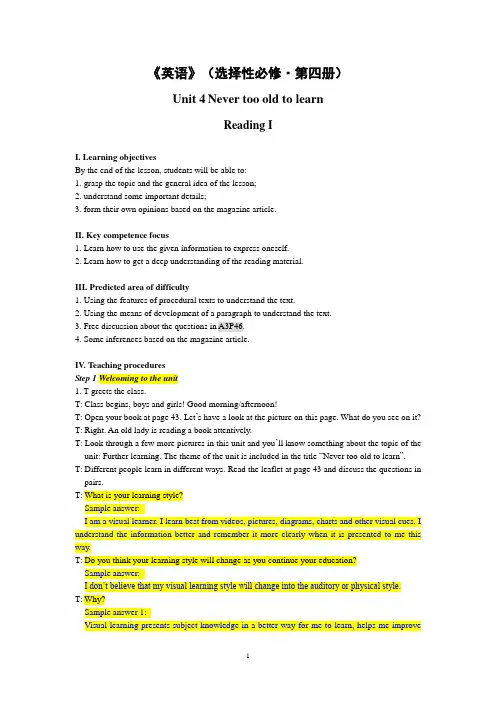
《英语》(选择性必修·第四册)Unit 4Never too old to learnReading II. Learning objectivesBy the end of the lesson, students will be able to:1. grasp the topic and the general idea of the lesson;2. understand some important details;3. form their own opinions based on the magazine article.II. Key competence focus1. Learn how to use the given information to express oneself.2. Learn how to get a deep understanding of the reading material.III. Predicted area of difficulty1. Using the features of procedural texts to understand the text.2. Using the means of development of a paragraph to understand the text.3. Free discussion about the questions in A3P46.4. Some inferences based on the magazine article.IV. Teaching proceduresStep 1 Welcoming to the unit1. T greets the class.T: Class begins, boys and girls! Good morning/afternoon!T: Open your book at page 43. Let’s have a look at the picture on this page. What do you see on it? T: Right. An old lady is reading a book attentively.T: Look through a few more pictures in this unit and you’ll know something about the topic of the unit: Further learning. The theme of the unit is included in the title “Never too old to learn”. T: Different people learn in different ways. Read the leaflet at page 43 and discuss the questions in pairs.T: What is your learning style?Sample answer:I am a visual learner. I learn best from videos, pictures, diagrams, charts and other visual cues. I understand the information better and remember it more clearly when it is presented to me this way.T: Do you think your learning style will change as you continue your education?Sample answer:I don’t believe that my visual learning style will change into the auditory or physical style.T: Why?Sample answer 1:Visual learning presents subject knowledge in a better way for me to learn, helps me improvemy powers of concentration and encourages me to be creative. I have been using this learning style for a long time, so it is the one that I am most comfortable with and the one I find benefits me the most. For these reasons, I believe my main learning style will not change.Sample answer 2:I think that my learning style will change because as a person and a learner I am always changing too. My current learning style is visual, and I like reading my study materials and writing summary notes that I can study from later. However, I don’t mind trying other learning styles if they help. I find that I also enjoy listening to podcasts and I am able to learn and remember a lot from them, so perhaps in the future I will also use the auditory style more often. 【设计意图:提示学生翻阅44、45和50图表,帮助学生形成本单元的主题概念。
book4_unit4_reading人教版高中英语必修四第四单元
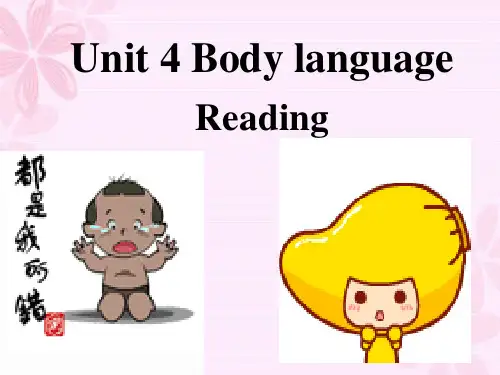
languages are bad. F
5.All members of a culture behave in the
same way.
F
TASK 3:Answer the following questions
1. Is the author of this passage male or female? How do you know ? 2.What were the two mistakes that the author noticed? 3.How can we understand “These actions are not good or bad”?
Fill in the blanks
Body language is used by people for sending messages to one another. In many countries in
the world, men k_is_s__ each other when they meet. In Britain, people usually s_h_a_k_e_ hands
think deeply
stomachache go this way
【课堂互动探究】
Look at the pictures. What are the following ways of communicating?
gesture
posture
facial expression eye contact
Para.1
ParSt.u2mmaDriizfefetrheentmsatuindeidnetas haaccvoerddiifnfegrteont (Parat.h2e-3m) eagnreinetginagndcuksetyomweorrsd. s.
2019外研版高中英语选择性必修四Unit4 Developing ideas reading
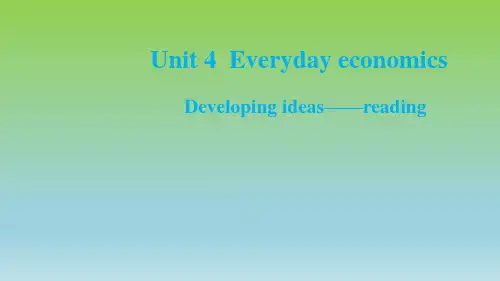
Pre-reading
Read Leo’s travel notes and answer the questions.
2. Which one do you think was more fun? Give your reasons.
One possible answer: I think the second one is more fun. During his second trip, Leo had a more wonderful experience by sharing so many things. He tasted delicious Chinese food, enjoyed a beautiful view but spent less money. That was brilliant!
Pre-reading Look at the title of the passage and talk about your understanding of it.
By sharing, you can be using what belongs to me, and so can I. The resources are used more often due to sharing.
Pre-reading Read Leo’s travel notes and answer the questions. 1. What are the differences between Leo’s two trips? 2) In 2008, Leo stayed in a hostel, while in 2018 he stayed in a shared flat. 3) In 2008, Leo didn’t know how to get to Houhai, while in 2018 he had a nice trip around Houhai by riding a shared bicycle.
新人教版高中英语必修四Unit4 Body Language Reading教学反思与心得体会
新人教版高中英语必修四Unit4 Body Language Reading教学反思与心得体会在这次县里组织的公开课比赛中,回顾过程,反思总结,收获还是挺多的,有可取之处,也有值得探讨尚需改进的地方。
还有幸观摩其他老师的授课,现将教学反思与心得体会总结如下,由于水平有限,反思与心得体会的内容可能很浅薄,望各位老师多多指教。
反思如下:可取之处:1、个人认为本课堂设计的过程给予肯定,贴切生活的问题开始本单元的话题,利用有趣的图片进行解释body language 进而导入主题,然后进行fast-reading和careful reading,对课文进行理解,有显现的简易知识,也有深度的讨论思考。
最后对课文进行升华,进行思考探讨与表达,学到了什么,为什么这么做,该如何做。
2、课堂设计导入leading in借助于当前话题母亲节, 是否向母亲表达爱意,一来教育学生关爱父母,二来引出交流表达的方式,从而导入主题what is body language,不仅实现了对学生的情感教育,而且很好的导入了本课主题。
3.整堂课完整有序,用贴切的生活图片等形式轻松而幽默,很轻易的就调动了学生参与的积极性;运用各种任务,贯穿整个课堂,使文章理解条理清晰;比较充分调动了学生的参与热情,使学生愿意积极配合完成各个环节,课堂气氛活跃。
4.以学生为主体,培养了学生合作思维与表达能力。
通过身势语的展示和the cultural mistakes的表演很好让学生参与到课堂教学过程中。
利用问题Is the author male or female?等问题让学生进行深度思维,交流想法,表达想法锻炼学生的思维能力与表达能力,从而实现“以学生为本”和“课堂有效性”。
不足之处:1. 学生思考的广度不够,阅读中停留在reading for information较多,而缺少reading for thinking,教学过程中基本上基于信息找寻的问题居多,而进行深入思考的的问题过少而且范围狭窄。
Unit 4 Extended Reading 课件-高中英语牛津译林版(2020)选择性必修第四册
Unit4 Extended Reading
Activity 1: Free talk
What is your target university?
e.g. its name or location, why it attracts you ...
What do you expect from your university life? Or worry about?
Part 2 (Para. 2–5) U_n__iv_e_r_s_i_t_y_l_i_fe
Part 3 (Para. 6) The preparation
for the future
(Para. 2)
_T_h__e__fi_r_s_t_d__ay _o__n_c_a__m__p_u_s_
(Para. 3)
D.He wanted to drop out of college.
Activity 3: Read for detailed information
5.What changes did the author make when he graduated?
A.He became strong.
D
__T_h_e__f_ir_s_t___ __a_s_s_ig__n_m__e_n_t
(Para. 4)
___G__r_o_u_p____ ___p_r_o__je_c_t_s__
(Para. 5)
_M__y_f_a_v_o__u_r_it_e p_r_o_f_e_s_s_o_r__
Activity 3: Read for detailed information
Activity 3: Read for detailed information
译林版高中英语选择性必修四Unit4 Reading 练习(雅礼版)
Unit 4 Never too old to learnReading II: Language PointsPart I: In-class exercises.1.Television is _______ effective means of communication.2.All the means _________________ (try) up to now.3.She is _______ no means an inexperienced teacher.4.She did not perceive ________ (she) as disabled.5.This discovery was perceived _____ a major breakthrough.6. I perceived _____ change in her behaviour last week.7.There is a general public __________ (perceive) that standards in schools are fall-ing.8.The kids found ______ hard to keep still.9.We stayed in a village ________ time has stood still.10.翻译:Still waters run deep.11.The course allows students ___________ (progress) at their own speed.12.The line of traffic ___________ (progress) slowly through the town in rush hours.13.The weather became colder as the day _________ (progress).14.Recently, the proposal ______________ (generate) a large amount of interest.15.The company, New England Electric, burns coal ___________ (generate) power.16.We should develop critical thinking skills by giving students opportunities ____________ (generate) ideas.17.These reasons are not sufficient ____________ (justify) the ban.18.My deskmate felt _____________ (sufficient) well to come to school the next day.19.His salary is ______________ (sufficient) to meet his needs.20.There's a ___________ (sufficient) of drama in these lives to sustain your interest.21.The government has taken a range of measures ___________ (boost) the local tourism.22.The cut in interest rates will give ____ further boost to/for the economy._______ did give me a boost to win such a big event.23.To get a higher mark than expected did __________ (boost) my confidence.Part II: Analysis of difficult sentences.Know that you will never know all there is to know and wonder at it.该句的主句为______________________,其中that引导一___________, 而该从句中又包含一定语从句________________来修饰_______,只不过该词后省略了关系代词____________。
高中英语人教版必修四unit4_Body_language-reading公开课课件ppt课件
Part 3: (Para 4 )
Part 4: (Para 5)
D) Examples of learned or cultural “body language”.
Matching the people and the different ways of greeting (para2&5)
Tony Garcia (Columbia) Julia Smith (Britain) Akira Nagata (Japan) George Cook (Canada)
Careful reading :
shakes hands and kisses others twice on each cheek Bows
shakes hands approaches others closely and touches their shoulder and kisses them on the cheek does not stand very close to others or touch strangers
Columbia
Britain
Julia Smith
George Cook Akira Nagata
Canada
Japan Jordan
Ahmed Aziz
Darlene Coulon
You
France China
Fast reading:
Which is the main idea of the text?
reading
Come here !
Good ! / Great !
“No,You can not do that"
OK
• She is deaf and dump, so body languagee.
- 1、下载文档前请自行甄别文档内容的完整性,平台不提供额外的编辑、内容补充、找答案等附加服务。
- 2、"仅部分预览"的文档,不可在线预览部分如存在完整性等问题,可反馈申请退款(可完整预览的文档不适用该条件!)。
- 3、如文档侵犯您的权益,请联系客服反馈,我们会尽快为您处理(人工客服工作时间:9:00-18:30)。
bowing
everyone
Name Description BodyToLanguage Whom
George Cook
man from Canada
shaking hands everyone
Ahmed man from shaking hands to men
Aziz Jordan nodding
to women
Darlene woman Coulon from
France
shake hands people she and kiss twice knows on each cheek
Country/ Area
Ways to greet each other
Britain
shake hands, do not stand very close to others or touch strangers when they meet
Part 2 (Para. 2 and 3) People from different countries express greetings in different ways.
Part 3. (Para. 4) Different peoples have different body languages.
Name Description Body Language
To Whom
Tony man from kiss on the everyone Garcia Colombia cheek
Julia woman
no touching
Smith from Britain
everyone
Akira man from Nagata Japan
Canada shake hands
Japan bow
Spain, Italy, approach others closely South and are more likely to
American touch them countries
France shake hands and kiss each
handshake
kiss
bow
hug
nod
blow a kiss
Reading
Look at the picture and the title of the passage on page 26. What do you think the topic will be?
JapaneseAkira Nagata
Second-reading
Read the passage again and then answer the following questions.
1. What does the text mainly talk about?
A. Two university students meet the international students in the airport.
3. There are many different ways to greet someone using words. How many ways can you think of to greet someone if you cannot speak?
Ways to greet someone without words: smile, wave, shake hands, hug, kiss, etc.
2. How can you communicate with someone if you cannot speak? Give an example. We can use body language to communicate with someone if we can’t speak.
George Cook (Canada)
Julia Smith (Britain)
Tony Garcia (Columbia)
First-reading
I. While reading, please try to divide the whole passage into several parts and find out the main idea. Part 1. (Para. 1) Meet the visitors at the airport.
Part 4. (Para. 5) Summary of body language.
II. How do different international students behave when they greet people? Complete the chart with information from the passage.
人教课标版 高一 必修 4 Unit 4
Unit 4 Reading Communication: No problem?
Brainstorming
1. What is the purpose of language? The purpose of language is to communicate with other people.
For example, if we’re angry, we might turn away and not talk to others. If we’re happy to see someone, we might smile and hold out our hands or open our arms.
other twice on each cheek
(men from) Middle East
and other Muslim cultures
shake hands and stand quite close to other men, nod to women and do not shake hands with them
